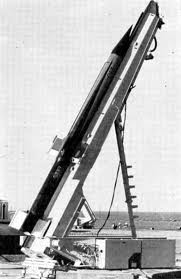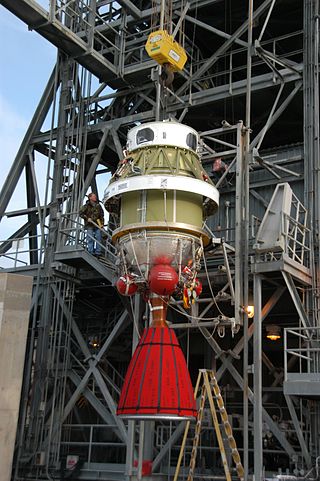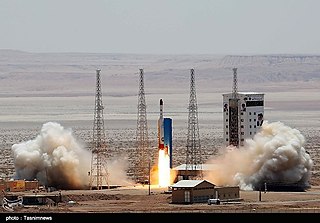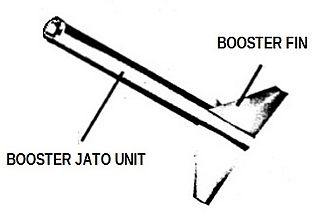
The Jupiter-C was an American research and development vehicle developed from the Jupiter-A. Jupiter-C was used for three uncrewed sub-orbital spaceflights in 1956 and 1957 to test re-entry nosecones that were later to be deployed on the more advanced PGM-19 Jupiter mobile missile. The recovered nosecone was displayed in the Oval Office as part of President Dwight D. Eisenhower's televised speech on November 7, 1957.

The Brazilian Space Agency is the civilian authority in Brazil responsible for the country's space program. It operates a spaceport at Alcântara, and a rocket launch site at Barreira do Inferno. It is the largest and most prominent space agency in Latin America.

Vostok was a family of rockets derived from the Soviet R-7 Semyorka ICBM and was designed for the human spaceflight programme. This family of rockets launched the first artificial satellite and the first crewed spacecraft (Vostok) in human history. It was a subset of the R-7 family of rockets.

The Scout family of rockets were American launch vehicles designed to place small satellites into orbit around the Earth. The Scout multistage rocket was the first orbital launch vehicle to be entirely composed of solid fuel stages. It was also the only vehicle of that type until the successful launch of the Japanese Lambda 4S in 1970.

Bélier is the designation of a French sounding rocket family. Three versions of the Bélier were launched between 1961 and 1970 at the CIEES launch facility at Hammaguir, the Salto di Quirra and Ile du Levant missile ranges, and Kourou Space Center.

Orion is the designation of a small American sounding rocket. The Orion has a length of 5.60 meters, a diameter of 0.35 m, a launch weight of 400 kg, a launch thrust of 7 kN and a ceiling of 85 kilometers. The Orion, built by NASA Goddard Space Flight Center's Wallops Flight Facility, is also used as an upper stage of sounding rockets, usually paired with a Terrier missile as the first stage, although Nike, Taurus and VS-30 rockets are also used.

The Dauphin is a French sounding rocket, flown six times between 1967 and 1979. It consists of a modification of the first stage of the Dragon with a larger payload nosecone.
Cora was a French experimental rocket. It was the largest rocket ever launched in Western Europe. It was primarily used for testing the second (Coralie) and third stages (Astris) of the multinational Europa Rocket, which was developed and produced by the European Launcher Development Organisation, the predecessor to the present day European Space Agency.

Centaure was a two-stage French sounding rocket consisting of a Venus first stage and a Belier second stage. It belongs to a family of solid-propellant rockets consisting of the Belier, Centaure, Dragon, Dauphin, and Eridan.

The INTA-300, also known as the "Flamenco", was a two-stage Spanish sounding rocket. It consisted of a launch stage from the type Heron and an upper stage of the type Snipe.
Astrobee is the designation of series of American sounding rockets with one to three stages.

The RD-170 is the world's most powerful and heaviest liquid-fuel rocket engine. It was designed and produced in the Soviet Union by NPO Energomash for use with the Energia launch vehicle. The engine burns kerosene fuel and LOX oxidizer in four combustion chambers, all supplied by one single-shaft, single-turbine turbopump rated at 170 MW (230,000 hp) in a staged combustion cycle.

VSB-30 - "Veículo de Sondagem Booster – 30" or "Foguete Suborbital VSB-30" is the designation of a Brazilian sounding rocket, which replaced the Skylark rocket at Esrange.

The Thorad-Agena is an American expendable launch system, derived from the Thor and Delta rockets.

This comparison of orbital launch systems lists the attributes of all individual rocket configurations designed to reach orbit. A first list contains rockets that are operational or in development as of 2023; a second list includes all upcoming rockets and a third list includes all retired rockets. For the simple list of all conventional launcher families, see: Comparison of orbital launchers families. For the list of predominantly solid-fueled orbital launch systems, see: Comparison of solid-fueled orbital launch systems.

The AJ10 is a hypergolic rocket engine manufactured by Aerojet Rocketdyne. It has been used to propel the upper stages of several launch vehicles, including the Delta II and Titan III. Variants were and are used as the service propulsion engine for the Apollo command and service module, in the Space Shuttle Orbital Maneuvering System, and on the European Service Module – part of NASA's Orion spacecraft.
The Atlas SLV-3, or SLV-3 Atlas was an American expendable launch system derived from the SM-65 Atlas / SM-65D Atlas missile. It was a member of the Atlas family of rockets.

Simorgh, also called Safir-2, is an Iranian expendable launch vehicle under development. It is the successor of the Safir, Iran's first space launch vehicle. Its mission is to carry heavier satellites into higher orbit than Safir.

The Nike stage or Nike booster, a solid fuel rocket motor, was created by Hercules Aerospace for the Nike Ajax (M5) Nike Hercules (M5E1). It was developed for use as the first stage of the Nike Ajax and Nike Hercules missiles as part of Project Nike.

The Astris was an upper stage developed by ERNO Raumfahrttechnik GmbH and MBB as the third stage of the Europa 1 launch vehicle. It was the German contribution to the project and only flew activated four times. The high failure rate of the three and four stage rocket meant that the project was cancelled.
















